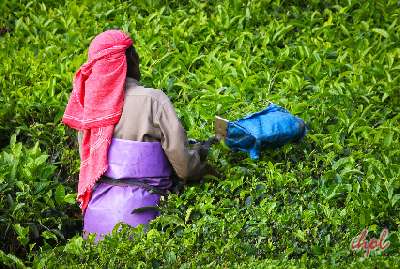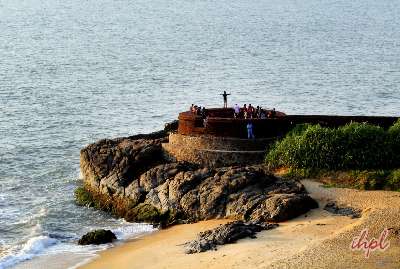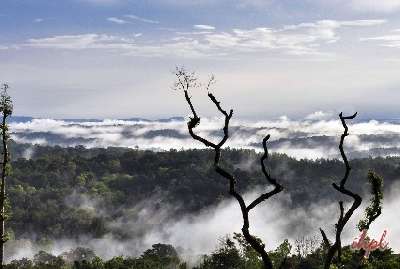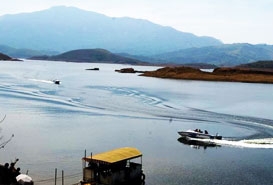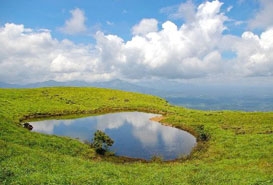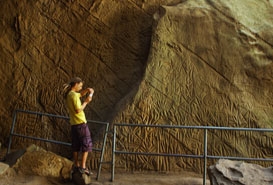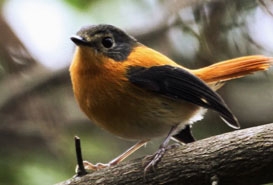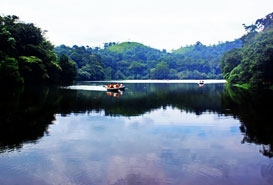At a distance of 30 km from Mananthavady, Thirunelli is a tiny hamlet at the foothills of the Brahmagiri Hills, a part of the Sahyadri Ranges in neighboring Karnataka. This village holds a lot of religious significance due to the presence of an ancient temple dedicated to Lord Vishnu and the nearby Papanashini stream. The place is also quite close to a thick forest, so it is popular among trekking enthusiasts and ornithologists.
Thirunelli Temple History
As far as the history of Thirunelli is concerned, the information about this place is limited. It is believed that till the 16th century, Thirunelli was an important religious center. Malayalam works belonging to the early 11th and 12th centuries, such as Unniyachi Champu, mention this place. Copper plate inscriptions dating back to the times of Bhaskara Ravi Varma I and II, who ruled the region in the 10th and 11th centuries, have been excavated from the village by archeologists.
The Malabar Manual, the work of William Logan, also refers to a place. It is said that when roads were being made, the workers found coins that belonged to the 9th and 10th centuries, pointing to the significance of the place at the time of the rule of Kulasekhara. One clearly shows that this place was an important religious place for centuries in northern Kerala.
Dedicated to Lord Vishnu in the form of Chaturbhuja, Thirunelli temple lies in the forest area of Brahmagiri. It is famed as the Kashi of the South because of its sacred importance. The other deities worshiped here are Nagam and Ganapathy. The temple is also compared to Gaya in Bihar state, as it is the venue of rites for the deceased souls to liberate them.
Check out Kerala Tour Packages, Kozhikode Tour Packages, Trivandrum Tour Packages, Munnar Tour Packages, Kochi Tour Packages
Thirunelli Temple Accommodation
The village of Thirunelli has a tiny population, and its residents are Adivasis. Apart from a guest house managed by the temple itself, the accommodation options are scarce. The temple premises have some small lodges as accommodation.
How to reach Thirunelli
The journey from Mansnthavady to Thirunelli is memorable, passing through thick forests, bamboo jungles, and elephant reserves. In a vast patch, there is no habitation but just expanses of paddy fields.
Opt for a journey on the Mysore road, from Mananthavady to Thirunelli, taking a turn from Kattikulam to arrive at Thirunelli. This tiny hamlet is situated on the border between Kerala and Karnataka. It can also be accessed from Kutta in Karnataka.
Legend behind Thirunelli temple and Papanashini stream
Although there is no documented history of the Thirunelli temple, it is said that the temple is over a thousand years old. Several exciting stories point towards the same.
One such story states that Lord Brahma himself constructed the temple. He was flying around the earth on his vehicle, a swan, and this is when he was mesmerized by the beauty of the Brahmagiri Hills. At the spot where he came down, he saw an idol of Lord Vishnu under an Amla tree. He established the idol there and called it the Sahyamalaka temple. Lord Vishnu blessed the area’s waters at his request, making them sacred and giving them the power to wash away all the sins they would bring in. This was the birth of the river Papanashini.
Another legend says that Garuda, the king of birds, was above Thirunelli with Amrit Kumb (the pot of the nectar of life) when Lord Brahma ensconced Lord Vishnu’s idol. A few drops from the pot fell into the stream, which became the sin-curing Papanashini River. The locals believe that every day, in the wee hours, Lord Brahma visits the temple to worship Perumal. For the same reason, before closing the temple at night, the head priest keeps fresh worshiping materials needed for pooja. In Malayalam, Thirunelli means the holy gooseberry.
Various ancient Hindu texts and puranas mention the Sahyamalaka temple. It is also said that Parshurama, an incarnation of Lord Vishnu, also visited the Thirunelli temple and completed the last rights of his father, the sage Jamadagni. He also bathes in Papanashini to make up for the sins of slaughtering Kshatriyas.
Papanasini and remarkable sights
Placed amid thick wilderness and mountains, Thirunelli offers some lovely views of the surrounding greenery. As the temple front is eastwards, the views of the sunrise are mesmerizing. Lush Bramagiri ranges on the north, Karimala on the west, and Narinirangimala on the south make the place greener and more beautiful.
They originated from Brahmagiri, Papanasini mountain stream is located at a distance of around 1 km from the temple. The temple premises also have a Panchatheertham temple pond. There is a massive stone in the center of the pond called Vishnupada, or the footprint of Lord Vishnu.
An architectural gem, the temple has been made with 30 granite pieces, and the floor is made from substantial square-shaped granite blocks. The temple’s architecture is typical Kerala, inspired by a tile roof in the inner sanctum, a granite lamppost on the entrance, and an open courtyard surrounding the Sanctorum. As there is no well in the temple, the water source is a stream from Brahmagiri that reaches the priest’s room through channels. Vilakkumaadam is a slim corridor made of granite pillars, although unfinished in the eastern area.
While going to Papanasini from the temple, cross a small bridge to arrive at a temple dedicated to Lord Shiva, called Gundicha Temple, also known as the Lord Vishnu temple. This temple has various beautiful sculptures.
This points out that Thirunelli has been blessed with a rare phenomenon of the presence of the Trinity – Brahma, Vishnu, and Mahesh (Shiva) in one place.
Explore 7 nights 8 days Kerala tour package
Folklores behind the watercourse and Gundika temple
Several stories are connected to the stream, pond, and other structures near Thirunelli temple. As far as Gundicha temple is concerned, the locals say that once, a pilgrim came here and grabbed an Amal fruit from the Amla tree. Later, he went to take a dip in the stream, and when he returned, he saw that the fruit had transformed into a Shivalinga.
There is also a legend behind the unfinished Vilakkumadam corridor in the Vishnu temple. One of Coorg’s chieftains started the corridor’s construction without permission from Kottayam Thampuran, who ruled over the area along with Thirunelli. He became quite angry with this, so the chieftain had to stop the construction in between. He then renovated the Lava Kusha temple at Kuthirakkode, near Thirunelli, with the remaining material.
It is believed that a princess from North Malabar commissioned the construction of the water channels that carry water to the temple. When, after a long journey, the princess arrived at the temple, she felt thirsty. On finding no water source, she empathized with the priest’s condition and commissioned the aqueduct’s construction. It is said the courtiers and servants of the princess, with the assistance of the local tribe, made a temporary aqueduct so that a stream could reach the temple from the Brahmagiri foothills.
The aqueduct, which ensures a continuous supply of water into the temple from the stream, is believed to have been constructed as per the instructions of a North Malabar princess. She came to visit the temple and felt thirsty after the long journey, but there was no water available. She sympathized with the plight of the priests there too, and immediately ordered the construction of a water supply system. Local people believe that her servants and courtiers constructed a temporary aqueduct from the stream at the foothills of the Brahmagiri to the temple with bamboo, with the help of local tribal people. After going back home, she sent masons to make an aqueduct using granite.
Festival of the Temple
The temple has become the venue for some festivals like Chuttuvilakku and Sreekrishnajayanthi. Shivarathri, Navarathri, and Puthari.
Ceremonies at Thirunelli Temple
It is said that homage at Thirunelli temple makes it easy for the deceased souls to travel to the next world peacefully. Done in lots, this ceremony begins with a prayer at the temple’s front. Then, the priest and the pilgrims visit Papanasini, carrying the items from the rituals. As per the instruction of the priest, the relative of the deceased in the river, pouring the content into the water, thus paying homage to their deceased loved one. A dip follows this in the holy waters, and they return to the temple for the last prayers.
Browse through our Kerala tour packages from Hyderabad, Kerala Tour Package from Chennai



